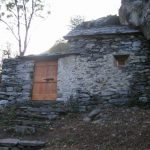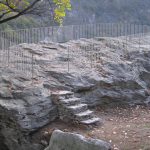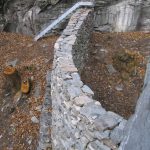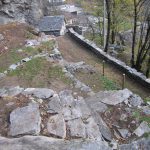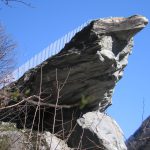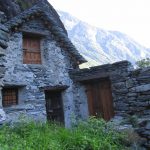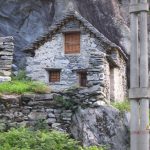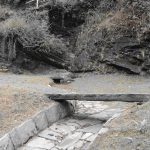Il sito di Sott Piodau
Il sito di Sott Piodau è un insediamento rurale di grande valore etnografico e paesaggistico, restaurato di recente per iniziativa dell’ex Comune di Bignasco e accessibile in pochi minuti su comodo sentiero. Il Piodau (da pioda, lastra di sasso) è la fascia rocciosa che sovrasta l’entrata meridionale di Bignasco: da qui, in epoca preistorica, si sono staccati macigni colossali che hanno sconquassato tutto il versante. In questo ambiente a prima vista ostile, improduttivo e difficilmente percorribile l’uomo ha ricavato piccole superfici coltivabili e alcune costruzioni di tipologia e funzioni diverse: due stalle e una cantina sotto roccia, una grà (metato) per l’essiccazione delle castagne e una lüèra, ossia una trappola per catturare i lupi, manufatto rarissimo in Ticino.
Uno dei massi di Sott Piodau sembra posato in precario equilibrio sul ciclopico monolito a ridosso della strada carrozzabile: è chiamato Il Fungoper la singolare somiglianza con un fungo gigantesco. Facilmente accessibile dal percorso principale, offre una splendida vista sul nucleo cinquecentesco di Bignasco e sull’entrata della Val Lavizzara.
A Sott Piodau la pietra naturale e la pietra lavorata si integrano in un connubio delicato e funzionale che testimonia grande sensibilità nell’interpretazione del territorio, un’eccellente conoscenza dei materiali e un alto grado di perizia tecnica. Questo insediamento si presentava già così nel Settecento, ma alcune strutture, in particolare quelle sotto roccia e la lüèra, sono sicuramente più antiche: documenti d’archivio e raffronti diversi le pongono a cavallo tra il XIV e il XV secolo.
Der Ort Sott Piodau
Sott Piodau, eine ländliche Siedlung von grosser historischer und landschaftlicher Bedeutung, wurde vor kurzem auf Initiative der früheren Gemeinde Bignasco restauriert und ist in wenigen Minuten auf gutem Weg erreichbar. “Piodau” (von „pioda“, also Steinplatte) wird die Felswand oberhalb der Südzufahrt nach Bignasco genannt, von der sich in prähistorischer Zeit gewaltige Felsblöcke gelöst und den ganzen Hang zerstört haben. In diesem auf den ersten Blick feindselig, unproduktiv und schwer zugänglich anmutenden Umfeld hat der Mensch kleine Anbauflächen und einige Bauten unterschiedlicher Art und Bestimmung angelegt: zwei Ställe und einen Felsenkeller, ein Dörrhaus zur Trocknung der Kastanien und eine „lüèra“, eine Wolfsfalle, ein im Tessin äusserst seltenes Manufakt.
Einer der Felsblöcke von Sott Piodau scheint in prekärem Gleichgewicht auf dem riesigen Monolithen an der Kantonsstrasse zu liegen. Aufgrund seines aussergewöhnlichen Aussehens wird er Der Pilz genannt. Von dem Hauptweg leicht zugänglich, bietet er einen prächtigen Blick auf den Ortskern Bignasco aus dem 16. Jh. und auf den Eingang in das Lavizzaratal.
Auf Sott Piodau verschmelzen Naturstein und bearbeiteter Stein zu einer zarten und gleichzeitig funktionellen Verbindung, welche von grosser Sensibilität in der Interpretation des Gebietes, hervorragender Kenntnis der Materialien und einem hohen Grad an technischer Fertigkeit zeugt. Die Siedlung sah bereits im 18. Jh. gleich aus wie heute. Einige Elemente wie vor allem die Unterfelsbauten und die Wolfsfalle sind jedoch zweifellos älter, ordnen doch Urkunden und verschiedene Vergleiche sie um die Wende vom 14. zum 15. Jh. an.
Le site de Sott Piodau
Le site de Sott Piodau est un habitat rural de grande valeur ethnographique et paysagistique, restauré récemment à l’initiative de l’ex commune de Bignasco et accessible en quelques minutes par des sentiers pratiques. Le Piodau (de pioda, dalle de pierre) est la bande rocheuse qui surplombe l’entrée méridionale de Bignasco: de là, à l’époque préhistorique, des blocs de pierre colossaux se sont détachés et ont fracassé tout le versant. Dans cet environnement à première vue hostile, improductif et que l’on peut difficilement parcourir, l’homme a créé de petites surfaces cultivables et des constructions de typologies et fonctions différentes: deux étables et une cave sous roche, une grà (séchoir) pour le séchage des châtaignes et une lüèra, c’est à dire un piège pour capturer les loups, ouvrage très rare dans le Tessin.
L’un des rochers de Sott Piodau semble être posé en équilibre précaire sur le monolithe cyclopéen adossé au chemin carrossable: il est appelé Il Fungo(Le Champignon) pour son étrange ressemblance avec un champignon gigantesque. Facilement accessible par le parcours principal, il offre une vue splendide sur le noyau du XVIème siècle de Bignasco et sur l’entrée de la Val Lavizzara.
A Sott Piodau la pierre naturelle et la pierre travaillée s’intègrent en un accord délicat et fonctionnel qui témoigne d’une grande sensibilité dans l’interprétation du territoire, une excellente connaissance des matériaux et un haut degré d’habileté technique. Cet habitat se présentait déjà ainsi au XVIIIème siècle, mais certaines structures, en particulier celles qui se trouvent sous roche et la lüèra, sont certainement plus anciennes: des documents d’archive et des sources diverses les situent à cheval entre le XIVème et le XVème siècle.
The Sott Piodau site
The Sott Piodau site is a rural settlement of great ethnographic and landscape value, recently restored through the initiative of the former municipality of Bignasco and easily accessible on foot in just a few minutes. The Piodau area (from pioda, stone slab) is a rocky strip overlooking the southern entrance to Bignasco. During prehistoric times, colossal boulders broke off from here, drastically changing the entire mountain side. In this apparently hostile, unproductive, and difficult to navigate environment, settlers obtained small pieces of land fit for cultivation and built constructions with different forms and functions: two barns and a cantina under rock; a grà for the drying of chestnuts; and the lüèra, a trap for capturing wolves and a very rare construction in Ticino.
One of the Sott Piodau boulders seems to rest precariously on the gigantic monolith next to the main road. It is called Il Fungo (mushroom) for its unique resemblance to a gigantic mushroom. Easily accessible from the main path, Il Fungo offers a splendid view of the 16th century nucleus of Bignasco and the entrance to Val Lavizzara.
At Sott Piodau natural and carved stones are integrated in a delicate and functional union that shows great sensitivity to the landscape’s possibilities, an excellent knowledge of materials, and a high degree of technical skill. Although the settlement took on its present form already in the 18th century, some structures—in particular those below rock and the lüèra—are older. Archive documents and historical comparisons date certain constructions to the 14th and 15th centuries.
Bignasco
Bignasco si trova alla diramazione delle valli Lavizzara (a NE) e Bavona (a NO). Sullo sperone alla confluenza dei rispettivi torrenti si erge la chiesa parrocchiale, collegata ai due versanti della valle da altrettanti «arditi ponti», che in passato conferirono al villaggio un ruolo chiave per il traffico di persone e merci. Il ponte di San Rocco, di fronte all’oratorio omonimo, è un’elegante struttura in sasso a due arcate asimmetriche che risale probabilmente al XVII secolo.
Il nucleo più antico è arroccato ai piedi di un’alta rupe sul versante sinistro: lungo le callaie e le stradine in selciato s’affacciano bei portoni incorniciati da architravi monolitici, sui quali sono incise numerose date del XVI secolo. In loco de Bugniasco si legge in una pergamena del 1230, ma le sue origini sono ben più remote se, come ritengono i linguisti, il suffisso «-asco» è di origine preromana. Dal XIX secolo Bignasco divenne meta attrattiva per numerosi viaggiatori che ne ammiravano la particolare posizione (a lato stampa di J. Weber, 1885 circa).
Bignasco
Bignasco liegt am Ausgangspunkt des Lavizzaratals (NO) und des Bavonatals (NW). Auf dem Ausläufer am Zusammenfluss der beiden Wildbäche erhebt sich die Pfarrkirche, mit beiden Talseiten verbunden durch ebenso viele „gewagte Brücken“, die dem Dorf in der Vergangenheit eine Schlüsselrolle für den Personen- und Warenverkehr verliehen. Die Brücke San Rocco gegenüber dem gleichnamigen Oratorium ist eine elegante, vermutlich aus dem 17. Jh. stammende Steinkonstruktion mit zwei asymmetrischen Bögen.
Der alte Ortskern liegt am Fuss eines hohen Felsens auf der linken Talseite. Auf die gepflasterten Strassen und Gassen öffnen sich schöne Eingagstore mit monolithischen Torstürzen, in die zahlreiche Daten des 16. Jh. eingraviert sind. In einer Urkunde von 1230 ist in loco de Bugniasco erwähnt. Wenn man aber den Sprachwissenschaftlern glauben darf, liegt sein Ursprung viel weiter zurück, ist doch die Nachsilbe «-asco» vorrömischen Ursprungs. Ab dem 19. Jh. wird Bignasco zum erklärten Ziel zahlreicher Reisender, welche seine einzigartige Lage bewundern (siehe Stich von J. Weber, ca. 1885).
Bignasco
Bignasco se trouve à l’embranchement des vallées Lavizzara (au NE) et Bavona (au NO). Sur l’éperon à la confluence des torrents respectifs, se dresse l’église, reliée aux deux versants de la vallée par autant de «ponts hardis» qui dans le passé conféraient au village un rôle clé pour le trafic des personnes et des marchandises. Le pont de San Rocco, devant l’oratoire homonyme, est une structure élégante en pierre à deux arcades asymétriques qui remonte probablement au XVIIème siècle.
Le noyau plus ancien est niché au pied d’un haut rocher sur le versant gauche: le long des passages et des sentiers pavés se trouvent de belles portes encadrées par des architraves monolithiques, sur lesquelles sont gravées de nombreuses dates du XVIème siècle. Sur un parchemin de l’année 1230, on peut lire In loco de Bugniasco, mais ses origines sont bien plus lointaines si, comme l’estiment les linguistes, le suffixe «-asco» est d’origine préromaine. Depuis le XIXème siècle, Bignasco est devenu une destination attrayante pour de nombreux voyageurs qui en admiraient la position particulière (ci-contre gravure de J. Weber, 1885 environ).
Bignasco
Bignasco is located at the fork of Val Lavizzara (NE) and Val Bavona (NW). The parish church rises on the ridge where the two rivers meet and is connected to both sides of the valley by two «bold bridges», which in the past gave the village a key role in the movement of people and goods. The bridge of San Rocco, right in front of the oratory bearing the same name, is an elegant stone structure with two symmetric arches and probably dates back to the 17th century.
The oldest nucleus clings to the foot of a cliff on the left side. Beautiful doors framed by monolithic lintels bearing various 16th century dates face the narrow streets and cobblestone pathways. A 1230 parchment mentions in loco de Bugniasco, but the village’s origins date much further back if linguists are correct in tracing the origins of the suffix «-asco» to pre-Roman times. Starting in the 19th century, Bignasco became an attractive destination for numerous travelers who admired its unique position (adjacent print by J. Weber, about 1885).
2. Le costruzioni sotto roccia
2.1. Il Fienile
Le frane preistoriche dovute al ritiro dei ghiacciai e all’erosione idrica sono un tratto forte della morfologia della Valmaggia, cui conferiscono un carattere duro e selvaggio. Se da una parte esse hanno sconvolto il territorio, rendendolo impraticabile e improduttivo, dall’altra hanno creato le premesse per lo sviluppo di un particolarissimo tipo di architettura rurale. Nel corso dei secoli l’uomo ha sfruttato gli anfratti nascosti tra i blocchi che si accavallano installandovi dimore temporanee e locali di lavoro, ha trasformato gli spazi ai piedi di rocce a strapiombo in rifugi per i suoi animali e depositi per il foraggio, ha scavato fresche cantine sotto i macigni e costruito piccoli grotti in cui conservare e gustare i frutti del suo lavoro, antropizzando così un territorio molto accidentato ed inospitale. Questa struttura, riparata dal grosso macigno, è ancora utilizzata per immagazzinare fieno e strame, mentre in origine era probabilmente una stalla per capre.
2.2. La stalla
Questa grande stalla ospitava un tempo una quarantina di capre: essa è dotata di mangiatoie lungo le pareti maggiori, mentre sul fondo è sospeso un soppalco in legno per le riserve di foraggio. L’edificio s’allunga per ben 15 metri alla base dello strapiombo: la parte sguarnita è coperta con un tetto a falda unica sostenuto da una carpenteria fissata con cavicchi di legno e sovrastato all’esterno da canalette incise nella parete rocciosa, le quali raccolgono l’acqua che scorre sul blocco, evitando così indesiderati stillicidi all’interno. Nei pressi dell’entrata si osservano interessanti dettagli nella lavorazione del sasso, in particolare il risparmio inciso nella volta rocciosa che consente una maggior apertura della porta, l’incavo nella soglia per la rotazione della stessa e alcuni sassi della spalla sinistra che presentano tracce dell’antica tecnica di taglio tramite cunei di legno.
2. Die Unterfelsbauten
2.1. Der Heuboden
Die durch den prähistorischen Rückzug der Gletscher und die Erosion des Wassers ausgelösten Bergstürze sind ein starkes Merkmal der Morphologie des Maggiatals und verleihen ihm einen harten und wilden Charakter. Sie haben einerseits die Gegend verwüstet und sie unwegsam und unergiebig gemacht, andererseits die Voraussetzungen für die Entwicklung einer einmaligen ländlichen Architektur geschaffen. Im Laufe der Jahrhunderte nutzte der Mensch die Spalten zwischen den übereinander liegenden Felsblöcken, um in ihnen vorübergehende Wohnstätten und Arbeitsräume einzurichten, wandelte die Räume am Fuss der überhängenden Felswände in Unterstände für sein Vieh und Lager für das Futter um, grub unter den Felsblöcken frische Keller und baute kleine „grotti“, in denen er die Früchte seiner Arbeit aufbewahren und geniessen konnte. Mit anderen Worten: Er erschloss ein gebirgiges und unwirtliches Gebiet. Der vom grossen Felsblock geschützte Bau wird heute als Heu- und Streuspeicher genutzt, während er ursprünglich wohl als Ziegenstall diente.
2.2. Der Stall
Dieser grosse Stall beherbergte einst ca. vierzig Ziegen. An den Längswänden liegen die Futterkrippen, während über dem Boden ein hölzerner Hängeboden für die Futtervorräte eingezogen ist. Das Gebäude erstreckt sich über gut 15 m am Fuss des Überhangs. Den ungeschützten Teil deckt ein Pultdach, das auf einem mit Holzpflöcken befestigten Holzbau ruht. Über dem Dach sind Rinnen in die Felswand gemeisselt, die das über den Felsen fliessende Wasser auffangen, umleiten und damit verhindern dass es in das Stallinnere tropft. Nahe dem Eingang stossen wir auf interessante Details in der Bearbeitung des Steins wie z. B. die in das Felsengewölbe gemeisselte Aussparung, dank der die Tür weiter geöffnet werden kann, die Aushöhlung in der Schwelle für die Drehung der Tür und einige Steine an ihrer linken Seite, welche Spuren der alten Spalttechnik mittels Holzkeile zeigen.
2. Les constructions sous la roche
2.1. La Grange
Les éboulements préhistoriques dus au retrait des glaciers et à l’érosion hydrique sont un trait fort de la morphologie de la Valmaggia, à laquelle ils confèrent un caractère dur et sauvage. Si d’une part ils ont bouleversé le territoire, en le rendant impraticable et improductif, ils ont d’autre part créé une base au développement d’un type d’architecture rurale très particulier. Au cours des siècles, l’homme a utilisé les renfoncements cachés entre les blocs qui se chevauchent, en y installant des demeures temporaires et des lieux de travail. Il a transformé les espaces au pied des roches en surplomb en refuges pour les animaux et en dépôts pour le fourrage, il a creusé des caves fraiches sous les blocs de pierre et il a construit de petites grottes dans lesquelles conserver et déguster les fruits de son travail, anthropisant ainsi un territoire très accidenté et inhospitalier. Cette structure, protégée par le gros bloc de pierre, est encore utilisée pour emmagasiner du foin et du fourrage, alors qu’à l’origine elle était probablement une étable pour les chèvres.
2.2. L’étable
Cette grande étable abritait jadis une quarantaine de chèvres: elle est dotée de mangeoires le long des parois les plus importantes, alors que sur le fond est suspendue une soupente en bois pour les réserves de fourrage. L’édifice s’étend sur 15 mètres à la base du surplombement: la partie dégarnie est couverte d’un toit à pan unique soutenu par une charpenterie fixée par des chevillettes de bois et surmonté à l’extérieur par des rigoles creusées dans la paroi rocheuse, qui récupèrent l’eau qui coule sur le bloc, évitant ainsi des stillations indésirables à l’intérieur. A proximité de l’entrée, on observe d’intéressants détails dans le travail de la pierre, en particulier la niche gravée dans la voûte rocheuse qui permet une plus grande ouverture de la porte, la cavité dans le seuil pour la rotation de celle-ci et certaines pierres du piédroit gauche qui présentent des traces de l’ancienne technique de coupe au moyen de coins de bois.
2. Constructions under rock
2.1. The hay barn
Prehistoric landslides caused by the retreat of glaciers and by water erosions are a determinant element of the morphology of Valmaggia, giving it a harsh and wild character. On one hand these landslides upset the valley’s landscape, rendering it unproductive and difficult to navigate; on the other hand they created the conditions for the development of a very unique type of rural architecture. Over the course of centuries, inhabitants exploited the ravines hidden among the overlapping boulders to create temporary dwellings and work areas. They transformed the spaces at the feet of overhanging rocks into animal shelters and forage storage, excavated cool cantinas below boulders, and constructed small grottos for the preservation and enjoyment of the fruits of their labor, thus taming the rough and inhospitable landscape.
This structure, protected by the huge rock, is still used to store hay and straw. Originally it was probably a goat barn.
2.2. The animal barn
This large barn used to house about forty goats. Along the structural walls are mangers and in the back a suspended wooden intermediate floor where the fodder was stored. The building extends as much as 15 meters at the base of the overhanging. The exposed part is covered with a single pitch roof, held up by a wooden structure fastened by wooden dibbles and towered externally by gutters carved into the rock. These gather the water that runs on the block of stone, preventing unwanted drippings inside. Near the entrance are interesting details in the workmanship of the stone, in particular: the cavity carved into the stone vault allowing a wider opening of the door; the cavity in the doorway enabling the door’s rotation; and stone carvings on the left side, showing traces of the old carving technique with wedge-shaped pieces of wood.
3. I terrazzi
Nella Bassa Valmaggia, caratterizzata da versanti scoscesi e da un fondovalle largo e pianeggiante, ma devastato dal fiume, le superfici utili e sicure erano spesso limitate alla fascia pedemontana. ‘Utili e sicure’ non sono quasi mai sinonimi di ‘comode’; nemmeno a Sott Piodau, dove al contrario l’uomo ha dovuto affrontare premesse naturali tutt’altro che allettanti: un territorio dalla morfologia molto accidentata, difficoltà di accesso e sfruttamento.
Il portale coperto immette nella zona dei coltivi: un seguito di spiazzi pianeggianti incastonati fra i macigni e collegati da scale, scalette a sbalzo e tacche incise nella roccia. Qui si coltivavano segale e patate, come pure la vigna; colture preziose, che andavano preservate dalla voracità delle capre. Per questo verso valle sono stati realizzati altissimi muri di terrazzamento, insuperabili anche per queste abili scalatrici, mentre gli interstizi fra i blocchi a monte sono chiusi da segmenti di muro che impedivano ogni accesso.
3. Die Terrassen
Das untere Maggiatal ist gekennzeichnet durch steile Bergflanken und eine breite, ebene, jedoch vom Fluss zerstörte Talsohle. Die nutzbaren und sicheren Flächen waren oft auf den am Gebirgsfuss gelegenen Streifen beschränkt. „Nutzbar und sicher“ stehen fast nie für „bequem“, auch nicht in Sott Piodau, wo sich der Mensch im Gegenteil alles andere als verlockenden natürlichen Bedingungen gegenübersah: Ein schwer zugängliches und schwer nutzbares Gebiet von gebirgiger Morphologie.
Ein Eingangsportal führt zu den Kulturen, einer Aneinanderreihung von Terrassen inmitten der Felsblöcke und durch Treppen, kleine freitragende Treppen und in den Felsen gehauene Scharten miteinander verbunden. Hier wurden wertvolle Kulturpflanzen wie Roggen, Kartoffel und Reben angebaut, welche vor der Gefrässigkeit der Ziegen geschützt werden mussten. Deshalb wurden talseitig hohe Terrassierungsmauern erstellt, die auch für diese gewandten Kletterer ein unüberwindbares Hindernis darstellten. Bergwärts wurden die Zwischenräume zwischen den Felsblöcken durch Mauerabschnitte verschlossen, die jeden Zugang verunmöglichten.
3. Les terrasses
Dans la Basse Valmaggia, caractérisée par des versants escarpés et par un fond de vallée large et plat mais dévasté par le fleuve, les surfaces utiles et sûres étaient souvent limitées à la zone se trouvant au pied de la montagne. ‘Utiles et sûres’ ne sont presque jamais synonymes de ‘pratiques’; pas même à Sott Piodau, où, au contraire, l’homme a dû affronter des conditions naturelles qui n’ont rien d’alléchant: un territoire à la morphologie très accidentée, une difficulté d’accès et d’exploitation.
Le portail couvert mène à la zone des cultures: une suite d’espaces plats enchâssés entre les blocs de pierre et reliés par des escaliers, des échelles en saillie et des entailles creusées dans la roche. Ici on cultivait le seigle et les pommes de terre tout comme la vigne; des cultures précieuses qui devaient être préservées de la voracité des chèvres. Pour cela, on a réalisé en aval de très hauts murs de terrassement, infranchissables même pour ces habiles escaladeuses, alors que les interstices entre les blocs en amont sont fermés par des segments de mur qui empêchaient tout accès.
3. The terraces
Lower Valmaggia is characterized by rugged slopes and a wide, flat valley floor, devastated by the river. The useful and safe areas were thus limited to the piedmont. ‘Useful and safe’ hardly ever meant ‘comfortable’—even in Sott Piodau, where the inhabitants faced uninviting natural conditions: a rough landscape difficult to access and exploit.
The covered portal leads to the cultivated area: a series of level clearings mounted among the boulders and connected by stairways, overhanging stairs, and steps carved into the rock. Rye and potatoes were cultivated here, in addition to vineyards—all precious crops that had to be protected from the voraciousness of goats. For this reason very high terracing walls—insurmountable even for these capable climbers—were built facing the valley; toward the mountain, wall segments closed off the narrow spaces between rocks and prevented access.
4. La grà
La grà è una piccola costruzione che veniva utilizzata in autunno per l’essiccazione delle castagne. Al piano terreno s’accendeva il fuoco, che era mantenuto ininterrottamente per circa tre settimane, mentre sul graticcio di legno si riponevano le castagne, rimescolandole periodicamente con una sorta di piccolo rastrello chiamato sbadígia, in modo da esporle ad un calore regolare. Il graticcio, ripristinato solo parzialmente affinché restasse visibile la carpenteria, in realtà era completo, per cui per introdurre le castagne si utilizzava la bocca di carico situata nel timpano. Dopo l’essiccazione esse erano raccolte in sacchi di tela e battute contro grossi ceppi, in modo da liberarle dalla buccia; così seccate potevano essere conservate a lungo: venivano consumate lesse, oppure macinate per farne una tipica focaccia (fiascia). Le due finestrelle, la nicchia d’angolo e gli intonaci lasciano presumere anche un uso diverso di questa costruzione, in alternanza con quello descritto.
4. Das Dörrhaus
Dieser kleine Bau diente im Herbst zum dörren der Kastanien. Das im Erdgeschoss angezündete Feuer liess man ca. drei Wochen ununterbrochen brennen, während die auf dem hölzernen Gitterrost ausgelegten Kastanien von Zeit zu Zeit mit einem „sbadígia“ genannten kleinen Rechen umgeschichtet wurden, um sie gleichmässiger Hitze auszusetzen. Der Gitterrost wurde nur teilweise restauriert, damit der hölzerne Dachstuhl sichtbar bleibt. Er deckte in Wirklichkeit den ganzen Raum ab, so dass die Kastanien durch die im Giebel angebrachte Ladeöffnung auf den Gitterrost gestreut wurden. Nach der Trocknung wurden die Kastanien in Leinensäcke gefüllt und gegen grosse Baumstümpfe geschlagen, um sie von ihrer Schale zu befreien. Die derart getrockneten Kastanien konnten lange aufbewahrt werden. Sie wurden in gekochtem Zustand gegessen oder gemahlen, um aus ihrem Mehl ein typisches Fladenbrot (die „fiascia“) zu backen. Die beiden kleinen Fenster, die Ecknische und die verputzten Mauern lassen vermuten, dass dieser Bau auch anders als eben beschrieben genutzt worden ist.
4. La grà
La grà est une petite construction qui était utilisée en automne pour le séchage des châtaignes. Au rez-de-chaussée, on allumait le feu qui était maintenu sans interruption pendant trois semaines environ, alors que l’on plaçait les châtaignes sur la claie en bois, en les mélangeant périodiquement avec une sorte de petit râteau appelé sbadígia, de façon à les exposer à une chaleur régulière. La claie, restaurée seulement partiellement afin que la charpenterie puisse rester visible, était en réalité complète, ainsi, pour introduire les châtaignes, on utilisait la bouche de chargement située dans le tympan. Après le séchage, elles étaient mises dans des sacs de toile et battues contre de gros troncs, de façon à les libérer de leur écorce; séchées ainsi, elles pouvaient être conservées longtemps: elles étaient consommées bouillies, ou bien moulues pour en faire une fougasse (fiascia) typique. Les deux petites fenêtres, la niche d’angle et les enduits font également penser à une utilisation différente de cette construction, en alternative à celle qui a été décrite.
4. The grà
The grà is a small construction used in the fall to dry chestnuts. On the ground floor was the fire, which was lit uninterruptedly for about three weeks. The chestnuts were placed on the wooden hurdle and stirred periodically with a small rake, called sbadígia, so as to expose them to consistent heat. The wooden hurdle, only partially reconstructed in order to show the wooden structure, ran the whole length. In order to insert the chestnuts one had to use the mouth located in the tympanum. Once the chestnuts were dried, they were placed in cloth bags and beaten against large stumps of wood in order to separate them from their shells. The drying process allowed the chestnuts to be stored for a long period of time. They were later boiled or milled to produce flour, which was used to make fiascia, a dense chestnut bread. The two small openings, the corner niche, and the plaster indicate that this construction might have had other uses in addition to the one just described.
5. La cantina
Nei depositi di detriti di falda vi sono spesso degli spifferi d’aria fresca, chiamati fiadairöi -da fiadàa, respirare- che conferiscono ai vani sotterranei condizioni di temperatura e umidità ideali alla conservazione di prodotti alimentari deperibili. L’eccellente isolazione della pietra e del terreno riducono al minimo gli scambi termici tra l’interno e l’esterno: le cantine sotterranee reagiscono solo lentamente e in misura trascurabile alle escursioni termiche giornaliere e stagionali, mantenendosi a temperature pressoché costanti. Presso questi frigoriferi ante litteram si riunivano le famiglie nelle sere d’estate o durante le giornate di festa.
La cantina che s’affaccia sul terrazzo di Sott Piodau è datata 1761: gli infissi robusti e il pesante catenaccio più che la modesta facciata tradiscono la presenza di un vano spazioso in cui si conservavano quantitativi importanti di provviste (formaggi, salumi e vino).
5. Der Keller
Innerhalb der Geröllhalden streicht oft ein frischer Luftzug, genannt „fiadairöö”, von „fiadàa” (atmen). Er verleiht den unterirdischen Räumen ideale Temperatur- und Feuchtigkeitsbedingungen für die Aufbewahrung von verderblichen Nahrungsmitteln. Die hervorragende Isolation durch Stein und Boden reduziert den Wärmeaustausch zwischen innen und aussen auf ein Minimum, so dass die unterirdischen Keller nur sehr langsam und fast unmerklich auf die täglichen und jahreszeitlichen Temperaturschwankungen reagieren und ihre Temperatur beinahe konstant bleibt. Bei diesen Vorläufern des Kühlschrankes trafen sich die Familien an den Sommerabenden oder Feiertagen.
Der auf der Terrasse von Sott Piodau gelegene Keller datiert von 1761. Die kräftigen Rahmen und der schwere Riegel lassen, mehr als die bescheidene Fassade, auf einen grossen Raum schliessen, in dem beträchtliche Mengen an Vorräten (Käse, Wurstwaren und Wein) aufbewahrt wurden.
5. La cave
Dans les dépôts d’éboulis de pierres il y a souvent des courants d’air frais, appelés fiadairöi -de fiadàa, respirer- qui confèrent aux compartiments souterrains des conditions de température et d’humidité idéales pour la conservation de produits alimentaires périssables. L’excellente isolation de la pierre et du terrain réduisent au minimum les échanges thermiques entre l’intérieur et l’extérieur: les caves souterraines réagissent seulement lentement et de façon négligeable aux excursions thermiques journalières et saisonnières en maintenant des températures presque constantes. Les familles se réunissaient auprès de ces réfrigérateurs ante litteram les soirs d’été ou bien pendant les jours de fête.
La cave qui donne sur la terrasse de Sott Piodau est datée de 1761: les huisseries robustes et le verrou lourd, plus que la façade modeste, trahissent la présence d’un large espace dans lequel on conservait des quantités importantes de vivres (fromages, charcuteries et vin).
5. The cantina
Fresh air drafts called fiadairöi—from the word fiadàa, to breathe—are often present in the strata of the rock and provide naturally carved underground spaces with temperature and humidity conditions ideal for the preservation of perishable food products. The excellent isolation of the rock and ground minimizes the thermal exchanges. These underground cantinas react negligibly to daily and seasonal temperature fluctuations and thus maintain an almost constant temperature. Families used to gather near these naturally-occurring refrigerators during summer evenings or special occasions.
The cantina facing the Sott Piodau terrace dates back to 1761. The robust fixtures and the heavy bolt more than its modest front reveal the presence of a spacious opening in which great quantities of provisions (cheese, charcuteries, wine) were preserved.
6. La lüèra
È un manufatto imponente, di cui non si conoscono simili all’infuori della Valmaggia. Una superficie di quasi 150 mq è chiusa tra la parete rocciosa a monte, l’enorme monolite a valle e due robusti muri a secco: quello a sud supera all’esterno i sette metri d’altezza, mentre quello a nord è realizzato con trovanti di grandi dimensioni fatti scivolare dal pendio soprastante. Non vi sono aperture, ad eccezione di un piccolo passaggio attraverso il quale, attirato da un’esca viva, entrava il predatore, facendo scattare un meccanismo che richiudeva un portello alle sue spalle. Il cornicione obliquo sporgente in due segmenti permetteva di raggiungere la corona del muro per guardare all’interno. L’età di questa struttura non ha potuto essere determinata con sicurezza, documenti d’archivio attestano però la presenza di una trappola per lupi a Bignasco già nel 1408; anche altre fonti -letterarie, iconografiche- sembrano convergere verso la prima metà del Quattrocento.
6. Die Wolfsfalle
Dieses stattliche Manufakt sucht ausserhalb des Maggiatals seinesgleichen. Eine Fläche von fast 150 m2wird bergwärts von der Felswand, talseitig vom riesigen Monolithen und beidseitig von zwei starken Trockenmauern begrenzt. Die Südmauer ist auf ihrer Aussenseite mehr als sieben Meter hoch, während die Nordmauer aus grossen Findlingen besteht, die man vom darüber liegenden Hang gleiten liess. Es gibt keine Öffnungen mit Ausnahme eines kleinen Durchgangs, durch den das von einem lebenden Köder angelockte Raubtier in das Innere gelangte und dabei einen Mechanismus auslöste, der eine Klappe hinter ihm schloss. Das zweiteilige schräge Kranzgesims erlaubte es, auf die Mauerkrone zu steigen und einen Blick ins Innere zu werfen. Das Alter des Bauwerks konnte nicht mit Sicherheit ermittelt werden. Urkunden bestätigen jedoch, dass es bereits 1408 in Bignasco eine Wolfsfalle gab, und auch andere literarische Quellen und Illustrationen scheinen mit der ersten Hälfte des 15. Jh. einig zu sein.
6. La lüèra
C’est un ouvrage imposant et l’on n’en connaît aucun autre qui soit similaire en dehors de la Valmaggia. Une surface de presque 150 m² est comprise entre la paroi rocheuse en amont, l’énorme monolithe en aval et deux murs robustes en pierres sèche: celui qui est au sud dépasse à l’extérieur les sept mètres de haut, alors que celui qui est au nord est réalisé avec des blocs de grandes dimensions que l’on a fait glisser de la pente située au-dessus. Il n’y a pas d’ouvertures, exception faite d’un petit passage à travers lequel le prédateur, attiré par un appât vivant, entrait en déclenchant un mécanisme qui refermait un portillon derrière lui. La corniche oblique saillante en deux segments permettait d’atteindre la couronne du mur pour regarder à l’intérieur. L’âge de cette structure n’a pu être déterminé avec certitude, des documents d’archive attestent cependant la présence d’un piège à loups à Bignasco déjà en 1408; d’autres sources, littéraires et iconographiques, semblent également converger vers la première moitié du XVème siècle.
6. The lüèra
The lüèra is an imposing outdoor construction unique to Valmaggia used to lure and capture wolves. It is an area of 150 square meters enclosed within a large rock on the mountain side, a huge monolith towards the valley below, and two robust stone walls: the south-facing one is more than seven meters high on the exterior, while the north-facing one is made of large boulders, slid from the slope above. There are no openings except for a small passageway through which the predator was lured in with live bate, triggering a mechanism that shut a wicket behind it. The slanted cornice protruding in two segments allowed a person to reach the top of the wall to look inside. Although the structure’s age cannot be determined with certainty, archive documents bear evidence of the presence of a wolf trap in Bignasco as far back as 1408 and other sources also indicate the first half of the 15th century.
7. Il bosco di castagni
Con nessun’altra pianta l’abitante delle Prealpi ha mai avuto un rapporto così stretto e vitale come col castagno. I suoi frutti hanno sfamato intere generazioni, soprattutto prima dell’arrivo del mais e della patata; erano inoltre esportati a quintali dagli emigranti stagionali per essere venduti sulle piazze delle città svizzere, tedesche e francesi; i maronatt ambulanti ne ricavavano modesti guadagni, alleggerendo nel contempo la famiglia di una bocca da sfamare durante la stagione più difficile.
Il castagno era l’albero per antonomasia: considerato alla pari di un bene immobile, sottostava ad un regime giuridico particolare, il jus plantandi, cioè il diritto di piantare castagni sul terreno della comunità conservando la proprietà dell’albero e dei suoi frutti per sé e per i propri discendenti. Monumentale e longevo, l’arbro forniva anche foraggio per gli animali da cortile, nutrimento per le api, strame per le lettiere delle vacche, legna da ardere e da opera, tannino per la concia delle pelli.
7. Der Kastanienwald
Zu keiner anderen Kulturpflanze hatten die Bewohner der Voralpen jemals eine engere und lebenswichtigere Beziehung als zur Kastanie. Ihre Früchte ernährten insbesondere vor dem Aufkommen des Mais und der Kartoffel ganze Generationen. Ausserdem wurden sie von saisonalen Emigranten zentnerweise exportiert und auf den Plätzen der schweizer, deutschen und französischen Städte verkauft. Die „marontt “ (Marroniverkäufer) genannten Strassenhändler erzielten damit nicht nur einen bescheidenen Verdienst, sondern entlasteten gleichzeitig die Familie, indem in der schwersten Jahreszeit ein Esser weniger am Tisch sass.
Die Kastanie war der Baum schlechthin. In gleichem Masse geschätzt wie ein unbewegliches Gut, unterlag sie einer speziellen Rechtsordnung, dem „jus plantandi”, d. h. dem Recht, auf dem Boden der Gemeinde Kastanienbäume zu pflanzen und für sich und seine Nachkommen den Besitz am Baum und an dessen Früchten zu beanspruchen. Der Baum, monumental und langlebig, lieferteauch Futter für das Kleinvieh, Nahrung für die Bienen, Einstreu für die Kühe, Brenn- und Bauholz sowie Tannin zum Gerben der rohen Tierhäute.
7. Le bois de châtaigniers
L’habitant des Préalpes n’a jamais eu un rapport aussi étroit et vital avec aucune autre plante qu’avec le châtaignier. Ses fruits ont nourri des générations entières, surtout avant l’arrivée du maïs et de la pomme de terre; ils étaient en outre exportés en quintaux par les émigrants saisonniers pour être vendus sur les places des villes suisses, allemandes et françaises; les maronatt ambulants en tiraient des gains modestes et délestaient en même temps leur famille d’une bouche à nourrir pendant la saison la plus difficile.
Le châtaignier était l’arbre par antonomase: considéré comme un bien immobilier, il était soumis à un régime juridique particulier, le jus plantandi, c’est-à-dire le droit de planter des châtaigniers sur le terrain de la communauté en conservant la propriété de l’arbre et de ses fruits pour soi et pour ses descendants. Monumental et vivace, l’arbro fournissait également du fourrage pour les animaux de basse-cour, de la nourriture pour les abeilles, les feuilles pour les litières des vaches, du bois à brûler et à travailler, du tanin pour le tannage des peaux.
7. The chestnut tree woods
With no other tree have the inhabitants of the pre-Alps had such a close and vital relationship as with the chestnut tree. Its fruits fed entire generations, especially before the arrival of corn and potatoes, and tons of chestnuts were exported by seasonal immigrants, who sold them on the piazzas of the main Swiss, German, and French cities. These seasonal itinerant maronatt made modest earnings from the sale of chestnuts, and their absence from their families alleviated the burden of one more mouth to feed during the most difficult season.
The chestnut tree was the most important tree—it was considered a piece of real estate and governed by its own law, the jus plantandi. This code determined a family’s right to plant a chestnut tree on communal property while maintaining ownership of the tree and the right to gather its fruits. Monumental and long-living, the arbro also provided forage for the farmyard animals, nourishment for the bees, hay on which the cows slept, wood to burn or use as construction material, and tannin for hides.
Testo di Flavio Zappa[/vc_column_text][/vc_column][/vc_row]

